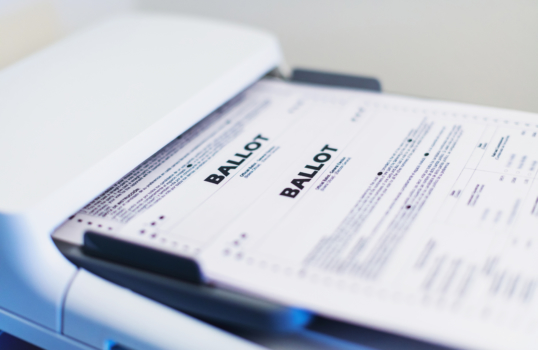Maricopa County’s Printer ‘Problems’ Behind the 2022 Election
Attorneys siding with embattled GOP gubernatorial candidate Kari Lake are insisting that Maricopa County’s mass Election Day failures were purposeful.
Mark Sonnenklar, a roving attorney with the Republican National Committee (RNC), told AZ Free News that the county experienced few of the issues during the primary election that suddenly metastasized on Election Day: faulty printer settings and incorrect ballot paper size.
Sonnenklar said that out of the 11 vote centers he visited on the primary election day, only one had major problems with tabulation: the North Phoenix Baptist Church location.
“My theory is that the county was on a trial run for the general. I believe in my heart, my gut tells me, that they planned to create this chaos on general Election Day,” said Sonnenklar. “They were testing methods to create that kind of chaos during the primary. That’s when they were figuring out how to do that.”
None have produced evidence that the Election Day failures were intentional.
Although tabulators were the initial suspect for the mass Election Day failures across the county, it turned out to be administrative errors prior to tabulation. Sonnenklar pointed out that it wouldn’t make sense for these issues to multiply due to the sheer amount of in-person voters, since printer settings and paper size wouldn’t be affected.
On Election Day, Sonnenklar said he witnessed mass tabulator issues at six of the 10 vote centers. The widespread failures were so pervasive that Sonnenklar, alarmed, reached out to other roving attorneys across the county to gather their experiences while fresh. Many reported witnessing the same failures, which lasted around eight hours and forced thousands of affected voters to cast ballots into a “door 3” slot to be manually tabulated later.
Maricopa County largely dismissed voter concerns, assuring that door 3 ballots would be tabulated properly and opting to push off a review of the chaos for a post-certification investigation. An estimated 71 sites (44 percent) out of the 211 vote centers were impacted (Lake’s attorneys claim that 132 sites were impacted, or 59 percent).
“I was receiving calls from everyone I knew in the Valley,” said Sonnenklar. “I knew there was a massive problem.”
Poll worker testimonies of election machine issues leading up to Election Day, given during the election certification in late November, aligned with Sonnenklar’s evidence gathered. Similar testimonies were also given during the Maricopa County Superior Court hearing in Lake’s lawsuit challenging the 2022 election results.
Sonnenklar stated that there were at least three primary causes of the tabulator malfunctions: timing marks and small white specks, which were uncovered before Lake’s trial, and incorrect ballot paper size, which was revealed during the trial.
Sonnenklar claimed that he spoke with election officials at various vote centers about the tabulator issue. He cited one example from a Mountain View vote center inspector who reportedly showed him that the timing marks weren’t printing correctly. The inspector backed up her claim with nearly 200 ballots fed into box 3 with faulty timing marks.
“She was definitive. She said that the problem was the timing marks on the ballot not printing dark enough,” said Sonnenklar. “She had 175 ballots that she had taken out of box 3. She showed me every one of those ballots and they were gray, they weren’t black. They hadn’t printed dark enough. All 175 of the ballots rejected by the tabulators had gray timing marks instead of black timing marks.”
As for the white specks: Sonnenklar said that another poll worker noticed that the bubbles indicating the chosen candidates weren’t filled in completely. They appeared to have little white specks where the printer failed to fill them in.
“He asked the voter if they would be willing to color in the white spec with the felt-tipped Pentel pens,” said Sonnenklar. “Every single time that the voter did that, it went through the tabulator just fine.”
The third issue, the ballot paper size, was discussed by Lake’s witness Clay Parikh, an information security officer, during the trial. Parikh testified that ballots from six of the six vote centers he inspected the day before Election Day printed 20-inch ballots on 19-inch paper. Sonnenklar noted that these six vote centers were selected randomly, and expressed concern that this represented a rate of 100 percent of vote centers being problematic.
Maricopa County didn’t dispute the erroneous ballot paper size, noting that it was a recurring issue over the last few years. However, they did dispute the number of affected vote centers (three versus Parikh’s sworn six) and pressed Parikh to admit that these ballots could be duplicated and counted. Parikh noted that those reprinted ballots could be counted, if done correctly. Sonnenklar questioned why the county didn’t solve the problem completely.
“The county maintained that the 19-inch paper on 20-inch ballots only occurred at three vote centers and that they knew about that problem from three prior elections,” said Sonnenklar. “Bottom line is, we think there were multiple reasons why the tabulators failed. In one case it was printers not printed properly. And in another case it was 19-inch paper printing 20-inch ballots.”
Sonnenklar insisted that the court wrongly dismissed Lake’s case because the judge, Peter Thompson, failed to consider whether the affected voters could’ve changed the outcome of the election. He said the judge only considered one legal standard, whether fraud occurred, but didn’t address if there was enough misconduct to render the election outcome “uncertain.” Sonnenklar contended that the judge created a high legal standard inconsistent with legal precedent.
Lake lost by over 17,100 votes, around the same number of voters affected by mass Election Day failures. Though this margin may seem slim, another race was even closer. Hamadeh, also contesting his election, lost by just over 500 votes.
“We just had to prove that the number of votes in the election could have changed the outcome of the election. I don’t think the defendants ever countered that,” said Sonnenklar. “On the legal front, I think we have a very strong grounds for appeal here. I think we made a pretty good case for overturning the decision of the trial court.”
Sonnenklar will be filing a reply brief to the county and Hobbs’ responsive briefs.
*****
This article was published by AZ Free News and is reproduced with permission.



